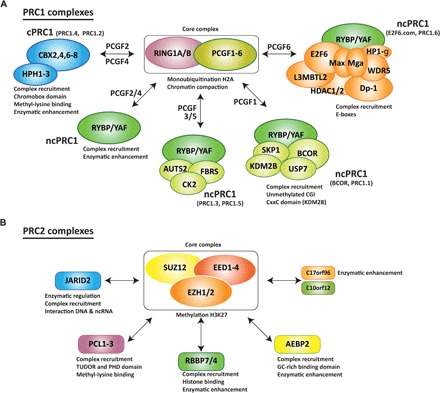Fig. 2. PcG complexes in mammals.

(A and B) PcG complexes are classified into two major families: (A) PRC1 and (B) PRC2. Both families contain core subunits present in all the subcomplexes of the family. The interaction of the core complex with other accessory proteins defines the complete composition of each subcomplex. These accessory proteins have been found to regulate recruitment to specific chromatin domains and/or to modulate the catalytic activity of the core complex. PRC1 complexes are divided into cPRC1 and ncPRC1 (A). The core complex can associate with distinct Pcgf proteins, which allows for an alternative nomenclature. Therefore, Pcgf2 and Pcgf4 are present in the cPRC1 complexes (PRC1.2 and PRC1.4, respectively), Pcgf2 and Pcgf4 are also associated with ncPRC1-containing Rybp or YAF proteins, Pcgf3 and Pcgf5 are present in the ncPRC1 complexes (PRC1.3 and PRC1.5), Pcgf1 is present in the ncPRC1 complex PRC1.1 (also known as BCOR), and Pcgf6 is present in the ncPRC1 complex PRC1.6 (also known as E2F6.com). (B) The trimeric PRC2 core complex can associate with different proteins present in the PRC2 complex at the same time.
